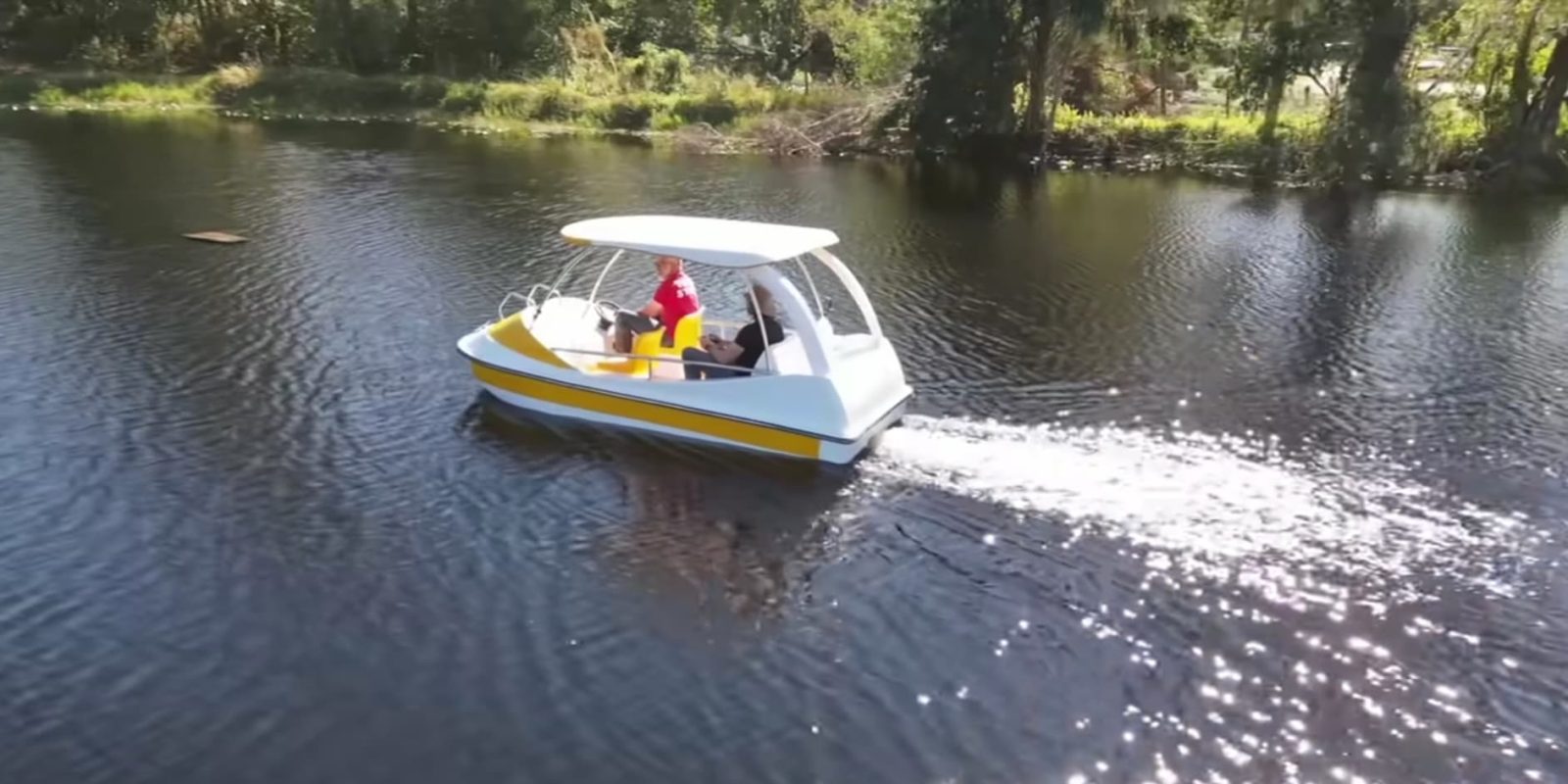
Ever since I helped my dad upgrade his fishing kayak with an electric motor, I’ve been angling for an electric boat of my own. And with some significant internet digging, a deep breath and, a leap of faith, I sent $1,000 off to China for an electric boat I found on Alibaba. A few months later, this is what showed up.
The timing was right.
I’d just gotten a fun electric mini-truck, I was often perusing Alibaba for more weird little electric vehicles for my weekly column on oddball EVs from China, and it had been a while since I made a major purchase that I worried about explaining to my wife.
After finding what seemed to be a nice little boat maker on Alibaba, I contacted the company, and the owner Frank showed me all the different models they produce.
There were some pretty neat options, but I ultimately settled on a nice little 14-footer electric boat with five seats and a beautiful front entry.
Price? US $1,080.00.

The only problem was that shipping was a fortune. I had to do LCL shipping (less-than-container-load), since I wasn’t about to fill a 40-foot container with these boats. I didn’t even really need one, let alone a dozen of them. LCL shipping meant I shared a container with other people and we each paid our share of the container. Except that sea freight last year was still insanely expensive, and my share would have come out to over $3,000.
Frank advised me to wait a bit, and over the next few months we saw the price slowly walking downward. Once it got to $2,200, I decided to pull the trigger. It was still twice the cost of the boat, but a five-seater electric boat in the US would easily be $10,000, so I was still coming out ahead.
I took a deep breath and sent Frank a bank transfer, then waited a few weeks until my boat was done. Frank and I had a video call so he could show me the boat, then he crated it up and got it on a bigger boat headed for Miami port.

Along the way, I had a customs broker file all of my import documents. I’d tell you how that process goes, but to be honest I don’t entirely understand the nitty-gritty details. That’s why customs brokers exist. They do all the legal stuff to make international commerce go smoothly.
I got hit with the Trump tariffs and a few other charges, adding around 30% to the boat’s cost before it even landed in Miami port. Then there were another $500 or so in arrival charges (basically a ransom you have to pay when your boat arrives), plus warehouse fees to release it from the warehouse that it gets unloaded into from the shared container.
The last little wrinkle before I could actually get my new electric boat released from the warehouse was that someone in China fat-fingered one of the many tracking numbers that goes into the import document filings on their side, meaning something didn’t match up. It was fairly complicated (house bill of ladings, master bill of ladings, AMS number, house IT number, ISF, other acronyms I don’t even remember), but my customs broker told me exactly what to say to the shipping company, word for word, and they sorted it out with the shipper in China. A few more stressful days later, something or other was re-manifested and my boat was clear.
Again, this was super complicated and I don’t claim to understand all the intricacies, which is why professionals generally handle this stuff. You can do it yourself to save a few bucks, but you better do your homework first to make sure all of your i’s are dotted and t’s are crossed.
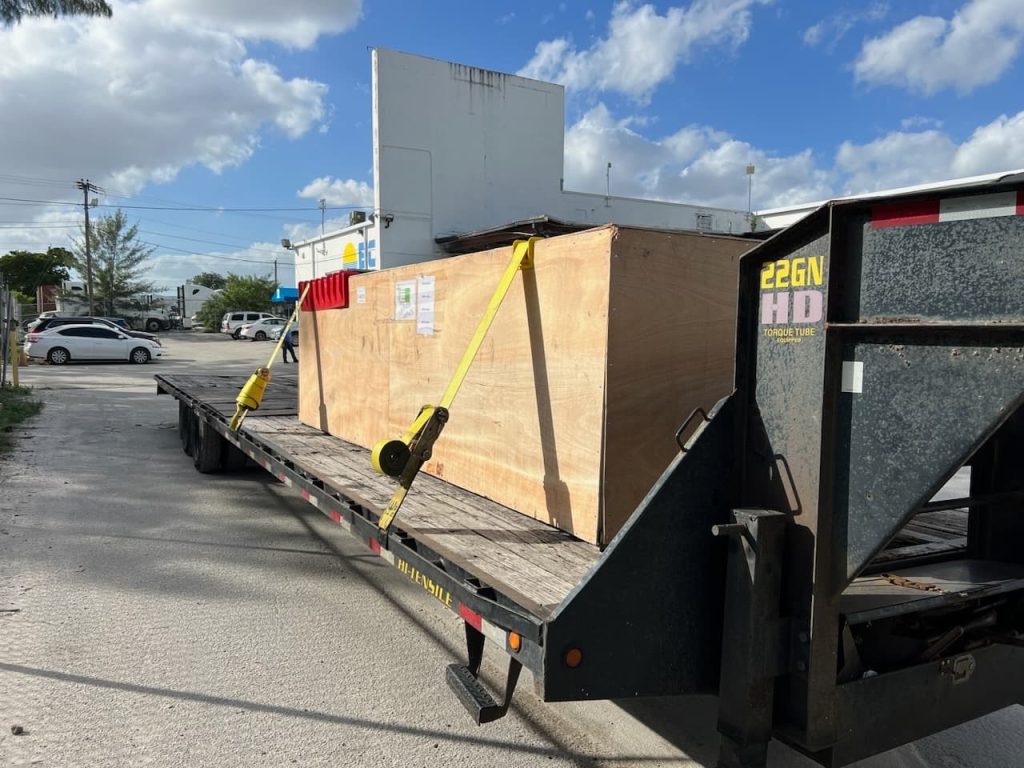
Then I had to have a guy truck the crate across Florida, which cost several hundred dollars more. Add in the customs broker fees and I was creeping closer to $5,000 for my $1,000 boat. Considering US-made electric boats that are closer to this size-class cost in the neighborhood of $40,000–$60,000, I figured I was still in good shape. And of course it’s nowhere as fancy as the awesome $300,00 electric boats I’ve been on, but it’s not exactly playing in the same league.
Sure, you can get a bare bones electric pontoon boat with an empty hull (add your own seats and, well, everything) for around $10K in the US, but this little five-seater Chinese electric boat was more or less complete.
I had the boat delivered to my parent’s ranch, where I intended to test it out in their 1-acre pond to ensure it was seaworthy before eventually putting it in a local river.
But first I had to unbox it. That process was a hoot, which you can see in my unboxing video here.
I even found a surprise inside, where Frank had included 10 free life jackets. Five were actually really nice and could easily be $50 life jackets in the US. The other five were compliance life jackets, and you could probably get all five for $50.
Still, $300 worth of free life jackets ain’t bad!


There was probably a solid $200-$300 worth of half inch plywood screwed onto the cage, all of which I was able to salvage and will surely come in handy in the future. The cage itself was welded with 2″ galvanized steel square tube. The whole thing was surprisingly-well made. You couldn’t have this crate built in the US for less $1,000, let alone the whole electric boat it was carrying.
I didn’t even have the boat out yet and I was already holding at least $500 in free material!
Sliding the boat out of the crate wasn’t easy, especially since it was loaded in from the top using a gantry crane in the factory. The boat weighs between 400-500 lb. (180-230 kg), and so it was a slide-one-end-at-a-time situation.
With the boat out of the crate, I finally got a chance to put hull to rule. It turned out that the 14-footer boat was more like 13’1″. That must have been quite a cold journey. Oh well, I’ll just round up.

Next I had to get the boat lifted up to the level of a trailer, and that was another lift-one-end-at-a-time situation while I slid wooden blocks under it to walk it up to approximately hip height. From that height, I was able to back the trailer under the bow and then my father and I pushed the boat the rest of the way onto the trailer.
Once on the trailer, I had to install the canopy and batteries. I chose to get the electric boat without the factory’s lead acid batteries so that I could install my own lithium iron phosphate batteries. The boat calls for 24V 100Ah batteries, but I decided to double that to get a solid 200Ah and around 5,000Wh of capacity. I figured I would never be in a situation where I wanted less battery, so more was better. I used EnjoyBot batteries, and they seemed like solid, good-quality batteries with good reviews.
The two 12V 200Ah batteries weigh around 50 lb. (23 kg) each, and would provide some good rear ballast down in the stern.
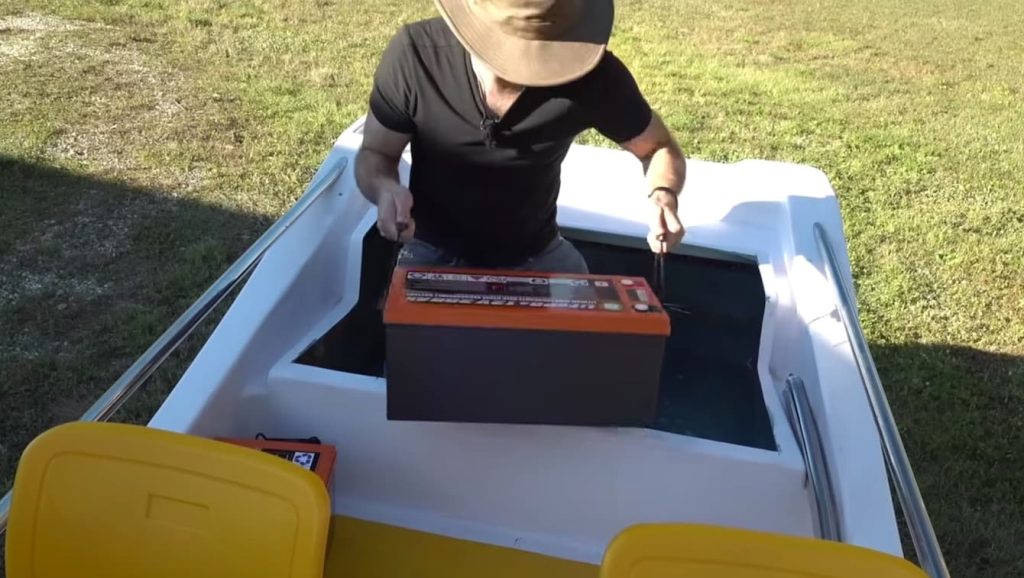
My parents’ pond doesn’t have a dock (yet) or a boat ramp, since we’ve just used it for kayaks. So I got a cool inflatable dock from a company called BOTE. Their Dock 10 is a 100-square-foot (10 square meter) floating dock that can be pumped up by hand in about 10 minutes. It’s amazingly rigid and the fake teak surface feels like real wood. There’s a tiny bit of bounce to it, but it’s weirdly solid-feeling. I know it looks like an inflatable mattress, but walking on it has you wondering if there’s a wooden or aluminum frame hidden in it somewhere.
Without a boat ramp, we just backed the trailer down the grassy bank and hoped the van didn’t go with it.
As if according to plan, my bright yellow electric boat slid nicely off the trailer and into the water. I don’t know why I was shocked that it worked so well, but I was.
I tied it off to the inflatable dock and did a quick water check by removing the rear bench seats to peer inside the hull. Everything was dry as a bone. Again, I don’t know why I was surprised, but it was a good feeling.

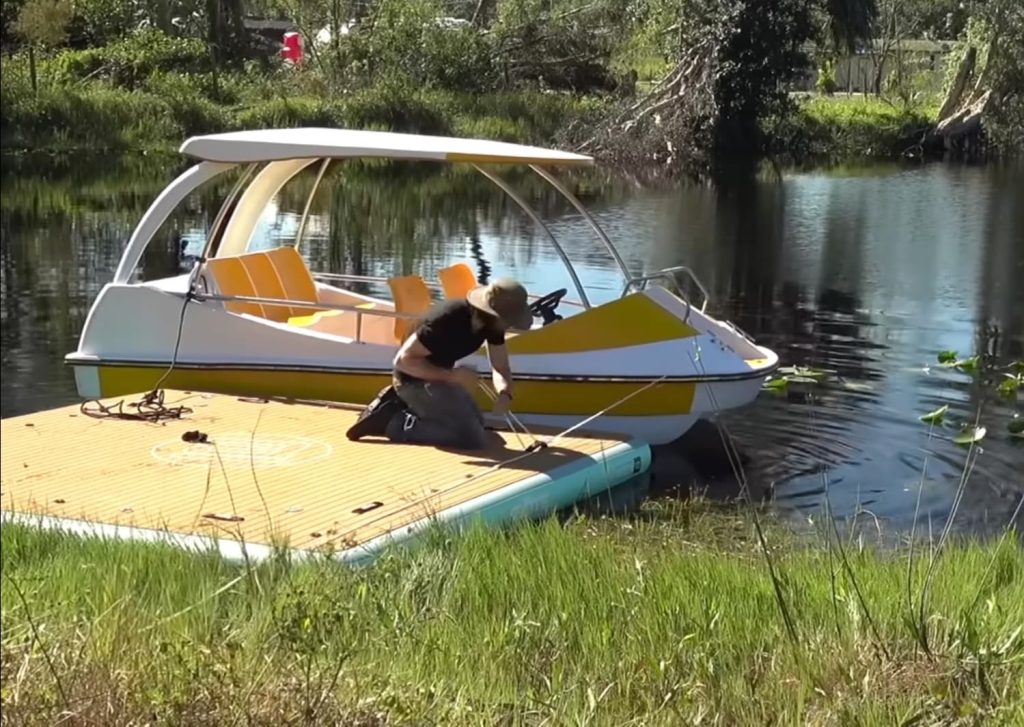

From there it was time for the maiden voyage. I took it out alone at first and found that I had a pretty good starboard list, though it didn’t seem to prevent me from navigating. My dad quickly joined me though and that evened out the weight.
The most apparent thing about this electric boat’s operation was that it just wasn’t very powerful. I didn’t expect a 500W (0.67 horsepower) motor to move a lot of water, and it didn’t. A GPS speedometer clocked us at 2 knots ( nearly 2.5 mph or 4 km/h!) on a speed run from bank to bank.
It was definitely more of a pleasure cruiser than a speedboat, but everything seemed to be working well!
An inspection of the propellor brought with it the realization that part of my speed problems were due to the inefficiencies of the prop design. Not only was it a cheap propellor, but it was sticking around 20% of the way out of the water. That meant I was sucking a lot of air down and had some serious cavitation going on. You can even see it in the photos.
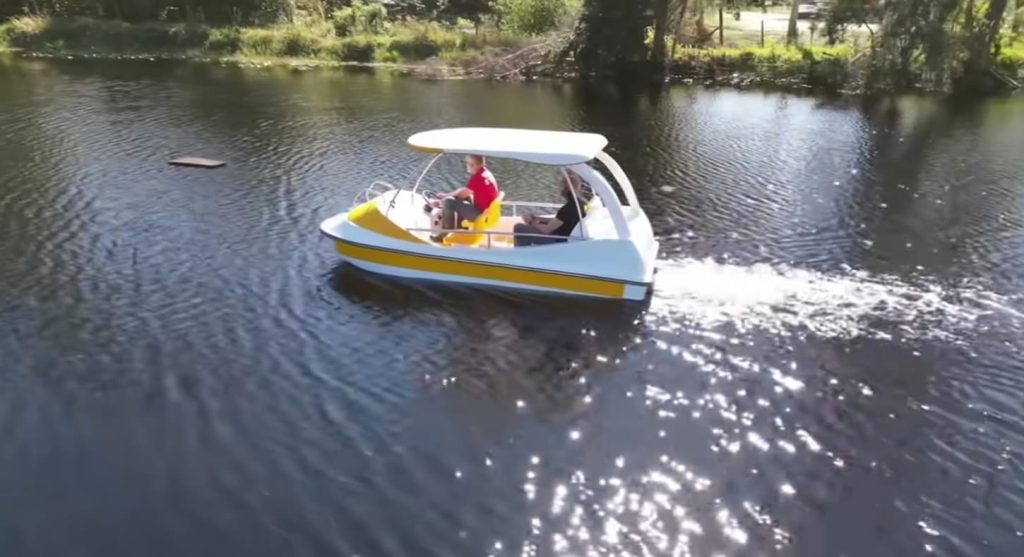
Putting a passenger in the rear helped get more prop into the water, but it still wasn’t completely submerged. It could be that the electric boat was designed for heavy lead acid batteries, and my lighter lithium batteries weren’t putting enough weight in the rear. I can try repositioning the batteries further aft and may look into ballasting, but it’s not an ideal solution.
I may also replace the drive unit altogether. Many people have suggested that I put in a jet ski’s propulsion unit, which would be kind of fun. I may put a couple of thrusters on instead though, as that would likely be simpler and give me fewer worries about leaks into the hull.
Some folks have suggested a trolling motor off the stern. That’d be the simplest solution, but it’d look funny and I’d rather put a little more effort into a slightly more elegant solution.
I’ll definitely be holding off on putting it in the river though. At its current power level, I don’t think it’d be a safe. I’m not sure it can overcome a decent current. So I’ll be waiting until I upgrade the motor before I head for any moving bodies of water. But as a lake boat, it’s kind of perfect. It’s not fast, but it’s comfortable and easy to use. It’d be perfect for all the folks that live on electric-only lakes that don’t permit combustion-engine boats.

As far as fit and finish goes, the boat is actually surprisingly nice. There are a few places where the fiberglass is inexplicably thicker and thinner, and there’s some paint overspray on the taffrails in one section where someone was obviously too lazy to tape them off. But by and large, the boat is surprisingly nice for $1,000.
I know this is where some people are going to go all “It’S NoT a $1,000 DoLlAr bOaT bEcAuSe YoU pAiD $5,000 fOr It!” on me. Well, the electric boat cost $1,080, which is what I paid to the factory. All the rest went to the container ship, the customs broker, taxes, US trucking, and other associated costs. The factory built and supplied the boat for $1,080, and I’m frankly amazed at what they could do for that price. Maybe I’m still blinded by free life jackets, but I’m pretty happy.
It’s unfortunate that you have to spend so much extra on top of the price of the product itself during the process of importing. But I still think I got an awesome deal. The boat seats five people and will be tons of fun to take out with my family on the pond. Once I get a more powerful motor in it, I’ll be excited to take it to the river and perhaps do a little fishing off the bow. That front entry area is a great place to stand up outside of the canopy.
Oh, and speaking of the canopy, you can be sure it’s going to get a solar panel setup soon. I’ve been known to do that to my other EVs!
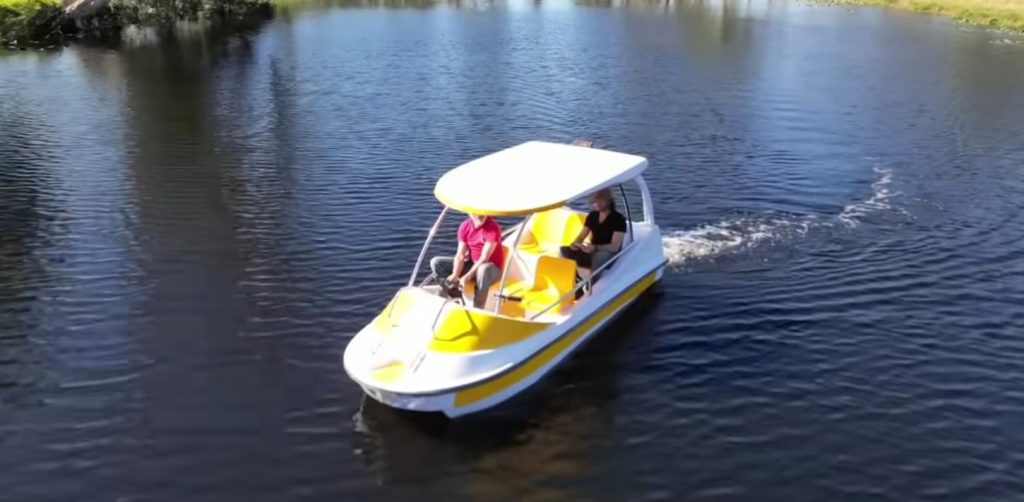
FTC: We use income earning auto affiliate links. More.






Comments